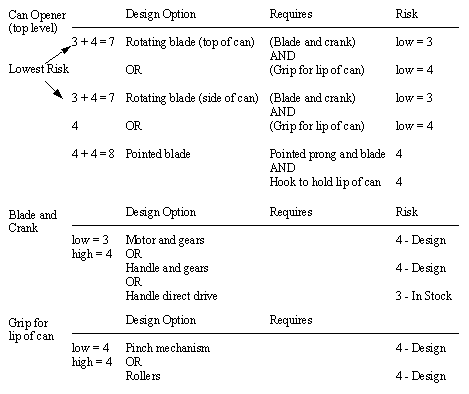
The basic 0 to 5 scores discussed before can be used to assign risks to the lowest levels of the design. These can then be combined from the lowest levels to the highest to calculate overall design scores. The first step is shown in Figure 3. Here the risks are shown as if each part or component is purchased. In all of the cases some design work is required so the purchase risk score is 4 for all. But we will assume that the direct drive handle is a commonly produced inhouse part and so the risk score is 3. If some of the components were available for purchase, or in stock already, the score would drop. In the cases where there is a sub-assembly no risk is assigned yet.

Figure 3 - Risks Assigned to Lowest Level Decisions
The overall design scores can be calculated by starting at the low level and working upwards. When parts are both required (AND) the scores are added. For a lowest risk case the lowest score is picked at each level and then combined up to the highest level of the tables. In this case the three options result in risks of 7, 7, and 8. In this case the two first options are less risky because the ‘Blade and crank’ are in stock and don’t require any special design. Even if this design is not chosen, it sets a benchmark for risk that other designs can be compared to for relative risk.

Figure 4 - Risks are Summed for Higher Level Decisions
In summary the process uses the following steps to find the least risky design, or the benchmark for design risk. If another design is picked the risk scores are selected by design choices, not by the lowest risk.
1. For each of the lowest levels in the decision tables risks are assigned as if the parts are purchased.
2. The risks are propagated up the tables to the highest levels. When there are ORs the lowest scores are picked for the least risky design. When there are ANDs the risks are added.
3. At the highest level pick the design with the lowest score.
In the conceptual stage of the design it is acceptable (but not desirable) to have scores of 4 or 5, but the objective of the design work is to reduce it to a 3 before moving to detailed design. In detailed design the options should be reduced to a 2, and eventually a 1 or 0.
[an error occurred while processing this directive]